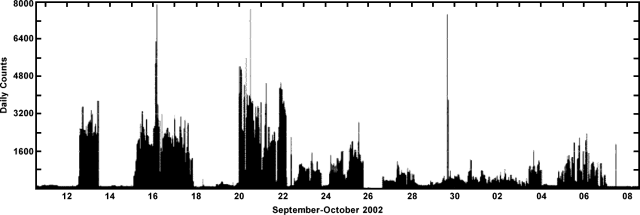Report on Ruapehu (New Zealand) — February 2003
Bulletin of the Global Volcanism Network, vol. 28, no. 2 (February 2003)
Managing Editor: Edward Venzke.
Ruapehu (New Zealand) Volcanic tremor episodes and Crater Lake temperature variations
Please cite this report as:
Global Volcanism Program, 2003. Report on Ruapehu (New Zealand) (Venzke, E., ed.). Bulletin of the Global Volcanism Network, 28:2. Smithsonian Institution. https://doi.org/10.5479/si.GVP.BGVN200302-241100
Ruapehu
New Zealand
39.28°S, 175.57°E; summit elev. 2797 m
All times are local (unless otherwise noted)
Between 6 and 16 September 2002 the Institute of Geological & Nuclear Sciences (IGNS) reported that there were four short-lived episodes of volcanic tremor at Ruapehu. The duration of these episodes ranged from 8 to more than 40 hours. Episodes with similar characteristics were recorded previously in 2002 on 21 February (~12 hours duration), 17 May (~24 hours), 29 May (~18 hours), 17 June (~24 hours), and 15 July (~8 hours). The September events were unusual because there were four tremor episodes in a ten-day period. Another IGNS report on 8 October noted that there had been five short-lived episodes of moderate-strong volcanic tremor since 6 September, with durations of 8 hours to more than 2 days (figure 25). Tremor levels were generally higher than normal background levels starting on 22 September.
 |
Figure 25. Plot of volcanic tremor amplitudes at Ruapehu, 10 September-8 October 2002. Courtesy of IGNS. |
The temperature of Crater Lake during two visits between 16 September and 8 October remained around 19°C, similar to the 19.4°C value measured on 30 August. Intermittent weak seismic tremor continued during November, along with a small number of volcanic earthquakes early in the month. Water temperature of Crater Lake measured during 22-29 November was 24°C, an increase of 5°C from the previous month. Weak tremor continued as of 13 December, accompanied by a small number of minor volcanic earthquakes. Volcanic tremor and earthquakes continued through 19 December, and the water temperature of Crater Lake was reported to be 35°C.
The water temperature measured at Crater Lake at the end of January was 32°C, down 8°C from two weeks earlier (40°C). Minor volcanic tremor continued through February, then steadily declined during 21-28 February to low background levels. On 5 March the temperature measured at Crater Lake had decreased another 2°C to 30°C. The lake was a uniform light gray color with some surface sulfur slicks. Seismic tremor remained at normal levels as of 21 March, but there were periods of moderate tremor on the nights of 14 and 15 March. The temperature of Crater Lake rose to 35°C on 15 March; there were sulfur slicks on the lake surface.
Geological Summary. Ruapehu, one of New Zealand's most active volcanoes, is a complex stratovolcano constructed during at least four cone-building episodes dating back to about 200,000 years ago. The dominantly andesitic 110 km3 volcanic massif is elongated in a NNE-SSW direction and surrounded by another 100 km3 ring plain of volcaniclastic debris, including the NW-flank Murimoto debris-avalanche deposit. A series of subplinian eruptions took place between about 22,600 and 10,000 years ago, but pyroclastic flows have been infrequent. The broad summait area and flank contain at least six vents active during the Holocene. Frequent mild-to-moderate explosive eruptions have been recorded from the Te Wai a-Moe (Crater Lake) vent, and tephra characteristics suggest that the crater lake may have formed as recently as 3,000 years ago. Lahars resulting from phreatic eruptions at the summit crater lake are a hazard to a ski area on the upper flanks and lower river valleys.
Information Contacts: Institute of Geological & Nuclear Sciences (IGNS), Private Bag 2000, Wairakei, New Zealand (URL: http://www.gns.cri.nz/).

